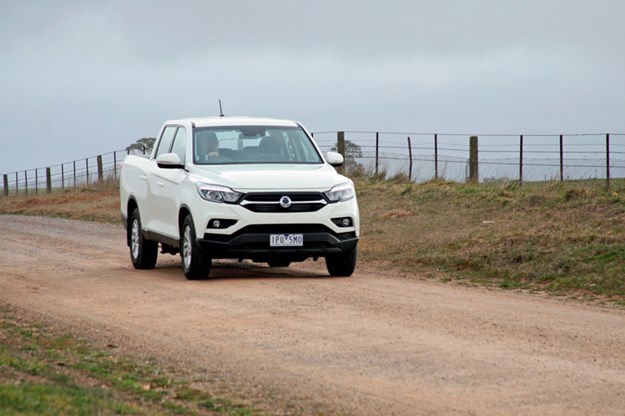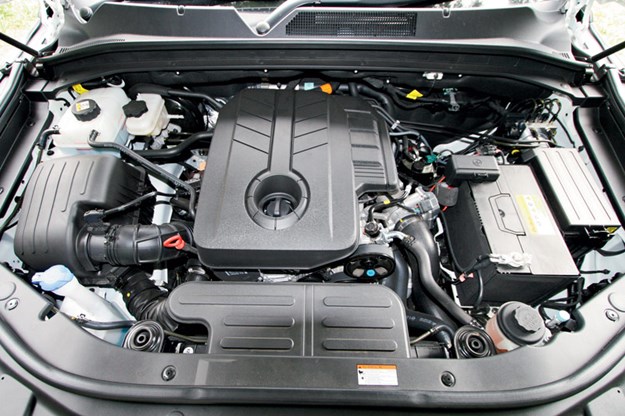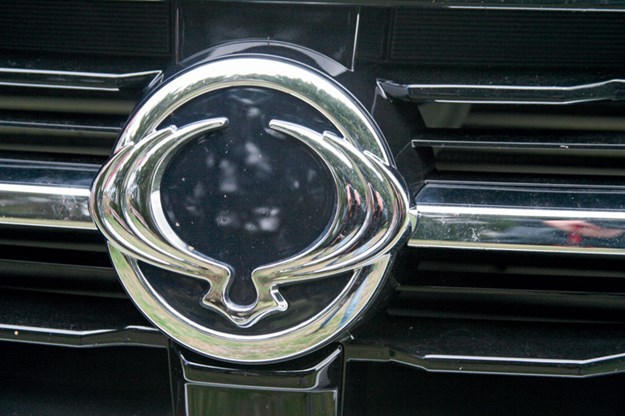Ssangyong has beefed up its new Musso ute range with a long-wheelbase leaf-spring variant called the XLV. Fraser Stronach tests it out
 |
|
The Ssangyong Musso XLV ute
|
Ssangyong may sound familiar to you, and you may have even have heard of a Ssangyong Musso, but perhaps remember it as a 4WD wagon and not a 4WD ute? That’s because the first Ssangyong to appear in Australia (in 1996) was a Musso and it was indeed a wagon, and at the time sold via Mercedes-Benz dealers. Some owners even took off the Ssangyong badges and replaced them with a Mercedes three-pointed star, perhaps to indicate the excellent Mercedes-Benz straight six under the bonnet.
If all that sounds confusing, it is, and a reflection of Ssangyong’s history here in Australia and more broadly.
Ssangyong has roots back to the mid 1950s when South Korea was emerging from the chaos of the still-not-fully-resolved Korean War. At one time it was owned by fellow Korean company Daewoo and subsequently by Chinese automaker SAIC, which just happens to produce the new-to-Australia LDV T60 ute, recently reviewed.
For a while Ssangyong even disappeared from the Australian market altogether but things are on the way up on two accounts.
Ssangyong’s purchase by India’s booming car, truck, bus and tractor manufacturer Mahindra about eight years ago has brought a huge investment in new models, while locally, as of last year, Ssangyong has set up a factory owned and backed distributor in Australia, which should bring on-going stability to the brand.
Among a number of new models, the Musso is a new-from-the-ground-up design that only appeared globally in 2018. What we have is the Musso XLV, which is the more heavy-duty model of two quite distinct ute variants (see ‘Musso Light Anyone?’).
The XLV comes in three equipment grades, the as-tested ELX, which is the base entry-level model and two more lavishly equipped models.
 |
|
The Musso’s ‘up-market’ feel continues with the pushbutton engine start. While there’s no reach adjustment for the steering wheel but the cabin is spacious and competitively big
|
CLIMB ABOARD
Entry level in this case equates to $36,990 drive-away, which means the Musso XLX comfortably undercuts the least expensive of the mainstream dual-cab 4WD utes in price.
But while it may be a ‘budget ute’, it doesn’t present as one with ‘smart key’ entry to a well finished cabin that looks more like that of a passenger car than a budget ute. There’s a long list of equipment too (see ‘Equipment Check List’) that’s more in like with a premium ute than a budget ute.
While there’s no reach adjustment for the steering wheel (as per many other more expensive utes), the seat and driving position is still comfortable in what is a spacious and competitively big, by class standards, cabin. There’s an adult-friendly back seat too complete with rear air vents.
 |
|
If you want a dual-cab ute with a big tub, then you have come to the right place
|
ON THE ROAD
The Musso’s ‘up-market’ feel continues with the push-button engine start and gets even better with the quiet and refined nature of its diesel engine that’s evident right from start-up.
Once underway, the 2.2-litre diesel continues to impress with generally effortless performance and notable refinement.
The Musso’s outright performance is still more modest than exciting but that said, it doesn’t give anything away to the lesser performing of the mainstream utes such as the Isuzu D-MAX, Mitsubishi Triton and even Toyota’s big-selling HiLux, despite the fact that its engine is smaller in capacity.
For its part, the six-speed automatic also does its job well in terms of shift selection and shift quality, and is essentially the same Aisin gearbox used in the HiLux and D-MAX. ‘Manual’ shift, if you want to use it, is via a toggle switch on the side of the shifter, which isn’t particularly nice to use.
While the Musso’s steering could be a bit sharper, the ride quality and general handling is more than acceptable when compared to what you get in the more expensive and more popular utes. Better still is the road-noise suppression, which helps build on the Musso’s refined, almost car-like persona.
 |
|
The 2.2-litre diesel continues to impress with generally effortless performance
|
IN THE PADDOCK
The Musso XLV has conventional part-time 4WD, selected via a rotary dial, as is the norm these days, but is more medium-duty than heavy-duty in terms of its 4WD ability. For really rough paddock work it’s certainly no HiLux or Ford Ranger due to its lower ground clearance, long rear overhang and lack of under-body protection but it’s still certainly well up to most paddock and farm work.
A bit more ground clearance would be nice, but given you would probably need to replace the standard road pattern tyres for something with a more aggressive tread pattern, you may as well go up a size from the standard 235/70R17s to gain some extra ground clearance as well.
 |
|
Ssangyong’s purchase by Mahindra has brought a huge investment in new models
|
LOAD AND TOW
If you want a dual-cab ute with a big tub, then you have come to the right place as the tub on the XLV is both longer and wider than the tubs on all the popular dual-cabs such as Ranger, HiLux, and the rest of them. All the popular dual cabs have tubs of 1.5m square, or a little smaller, whereas the XLV’s tub is more like 1.6m square. More importantly, it can take a full-size pallet between the wheelarches, which gives you much of the working ute functionality of an aftermarket tray without all of the disadvantages, a feat only shared with Volkswagen’s Amarok amongst the popular utes.
The XLV’s leaf spring set-up comprises a notably long (1.4 metre!) four-leaf spring pack with a fifth helper leaf underneath. The long main spring pack helps with the unladen ride despite the maximum payload rating increasing 230kg from the coil-spring model to over 1,000kg. At the same time the combined gross mass (GCM) – what you can carry and tow at the same time – is up 390kg from the coil-spring model to 6,370kg. That’s a higher GCM than the likes of Ranger, Amarok V6, and the like, which top out at 6,000kg.
OWNERSHIP
As previously mentioned, Ssangyong now has a fully factory owned and backed local distributor, which is something that Ssangyong hasn’t previously enjoyed in this country. The vehicle itself is backed a seven-year, unlimited-kilometre warrant, seven-year road-side assistance and seven-year fixed price servicing based on yearly 15,000km services at $375 a time. Currently Ssangyong has 41 dealers nationally with more in negotiation.
SUM UP
The Musso XLV makes a convincing ‘buy-me’ argument on many counts, not least its budget pricing given the generous equipment list, sophisticated safety kit included. Add in its impressively refined powertrain, roomy cabin, decent unladen ride and huge, functional tub and you have both a family ute and a work ute in one.
Ssangyong Musso XLV prices*
ELX (manual): $34,990
ELX (auto): $36,990
Ultimate (auto): $41,990
Ultimate+ (auto): $43,990
*Prices are recommended drive-away
Ssangyong Musso XLV ELX (auto) specs
Engine: 2.2-litre, four-cylinder turbo diesel
Max power: 133kW @ 4,000rpm
Max torque: 420Nm @ 1,400–2,800rpm
Gearbox: six-speed automatic
4X4 system: dual-range part-time
Construction: separate chassis
Front suspension: independent/coil springs
Rear suspension: live axle/leaf springs
Brakes: discs front/discs rear
Wheel/tyre spec: 235/70R17 111T
Kerb weight: 2,160kg
GVM: 3,220kg
Payload: 1,060kg
Towing capacity: 3,500kg
GCM: 6,370kg
Overall length: 5,405mm
Width (no mirrors): 1,950mm
Height: 1,855mm
Wheelbase: 3,210mm
Track (F/R): 1,640mm/1,640mm
Ground clearance: 215mm
Fuel tank capacity: 75 litres
ADR fuel claim: 8.2 litres/100km
Test fuel use: 9.4 litres/100km

